

The south processionSorry about these pictures: one notable problem of the site and architecture of the new museum is that the space is very narrow between the enclosure wall of the Ara Pacis and the wall of the museum. Therefore, it is impossible to get an appropriate distance from the enclosure wall. Furthermore, dramatic shadows often fall on the sides, especially noticeable on the north side (page 3). | ||
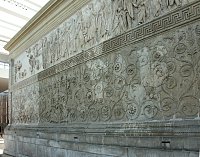
|
On both the north and south sides of the enclosure, priests, cult attendants, magistrates, and historical men, women and children are crowded into rows of figures. In some cases, there is controversy over which personages are represented, and at least two purposes for the procession have been described: it could be the reception ceremony offered Augustus on his triumphant return home from Gaul and Spain or it could be the "inauguratio" of the Ara Pacis itself, depicting part of the ceremony consecrating the space where it would be located. The procession is located on both sides of the exterior of the enclosure, that is, it is one single procession with the figures walking from east to west on both sides toward the western (main) entrance of the Ara Pacis. The realism of these processions contrasts with the interior of the enclosure war and the altar itself where symbolic associations predominate. See page 4. | |
| The lead figure, missing most of his body, in the left image below, is Augustus. An undisputed attribution, he wears a laurel wreath and a veil since he is portrayed as a priest. Since most of his body has been lost, it is not clear what action he is engaged in, although it seems as if the procession has stopped around him. Agrippa is the figure with the toga covering his head. See below. The viewer must imagine the procession as preceding in double file since the figures on the far side are in lower relief with their heads in the spaces between the frontal figures. | ||

|
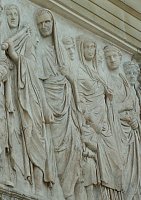
|
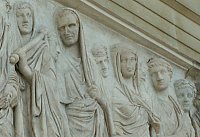
|
| Behind Augustus are four flamines maiores who wear the characteristic leather hat with a metal point. These are priestly officials who attend various Roman cults. The last flamen is followed by an assistant who has a ritual axe on his shoulder. | 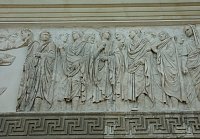
|
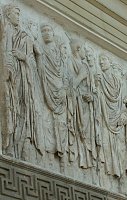
|
| Another undisputed identification is Agrippa, who is portrayed with part of his toga covering his head and who carries a scroll. He was the most important official after Augustus, the princeps. Before him are officers of the state (or state religion) and behind flow members of the imperial family. Agrippa was Augustus' son-in-law, having married Augustus' daughter Julia and fathered the heirs to the empire, Gaius and Lucius Caesar. The child holding his robe is probably Gaius; he wears a short tunic (the "Trojan" style) and looks up at the woman behind him, generally identified as Livia, Augustus' wife, and the most prominent of the women in the procession. (She has also been identified as Augustus' daughter, Agrippa's wife, and mother of the heirs to the throne. | ||
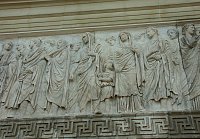
|
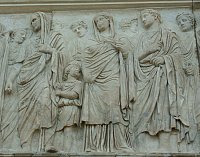
|
Agrippa and family group |
Family groupsOther family groups have been identified as Antonia Minor, Augustus' niece, her husband Drusus with their young child between them. His toga is fastened with a bulla. The next family group includes Antonia Maior, her husband, and their daughter and son (the latter who would become Nero's father). | ||
| The woman in the background has her finger to her lips, as if to suggest respectful silence. It has been speculated that this is a reference to Drusus' death in 9 BCE, the year the altar was completed (Rossini 71 referring to an article by La Rocca). Drusus here is depicted in a military cloak. | 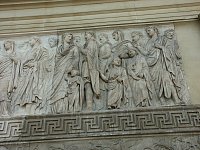
|
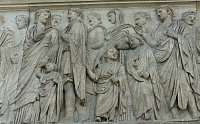
|
Works Consulted:
Orietta Rossini. Ara Pacis. Rome: Electa, 2006.
Marilyn Stokstad. Art History. Upper Saddle River, N.J.: Pearson Edu., 2005.
 Click here to return to index of art historical sites.
Click here to return to index of art historical sites.
 Click here to return to index of artists and architects.
Click here to return to index of artists and architects.
 Click here to return to chronological index.
Click here to return to chronological index.
 Click here to see the home page of Bluffton University.
Click here to see the home page of Bluffton University.

